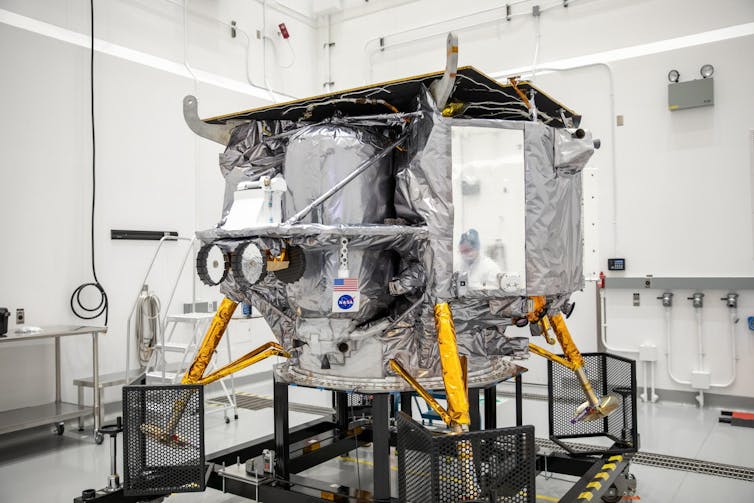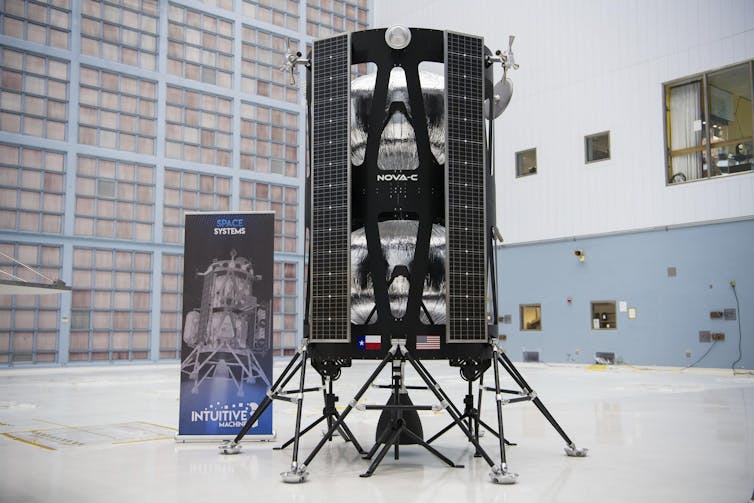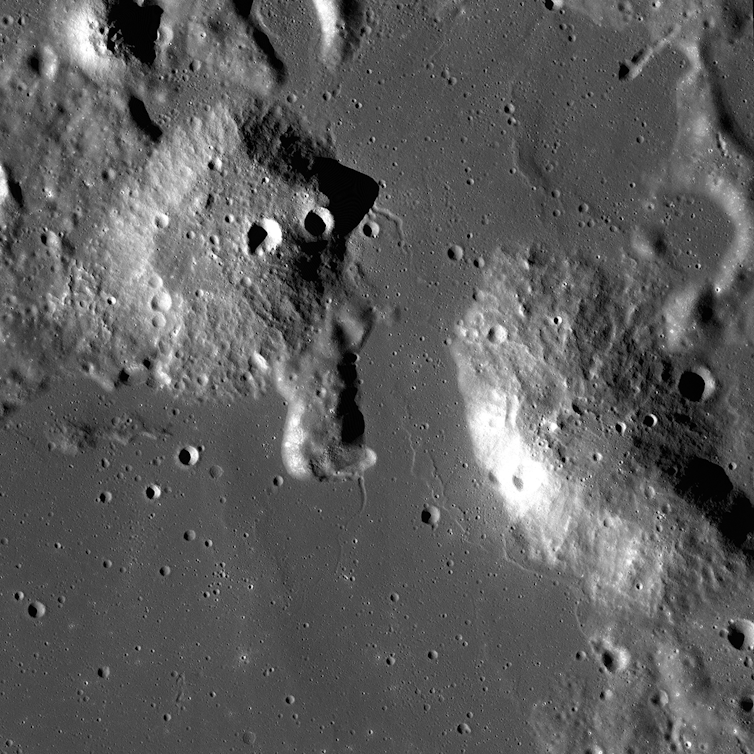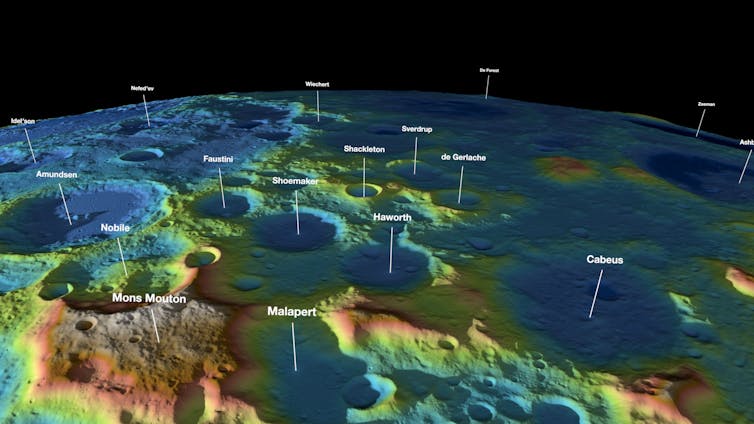Two commercial spacecraft are scheduled to launch to the Moon early in 2024 under a Nasa initiative called the Commercial Lunar Payload Service CLPS. This programme is intended to kickstart a commercial transportation service that can deliver Nasa experiments and other payloads to the lunar surface.
If successful, these missions will represent the first landings on the Moon by spacecraft designed and flown by private companies. They could potentially open up a new era of commercial lunar exploration and science.
CLPS was inaugurated by Nasa in 2018. An initial pool of nine companies received an invitation to join the programme. They included Astrobotic and Intuitive Machines, the two companies behind these missions. Both missions expect to land within a week after lift-off.
The first launch, and the first Nasa flight of 2024, is the Peregrine lunar lander, built by Pittsburgh-based Astrobotic. It is scheduled to launch at the earliest on January 8. Broadly speaking, the lander is a box the size of a medium-sized garden shed containing several separate experiments.
These include a set of mirrors called a laser retro-reflector array, used for accurate positioning of the lander from orbit. There are also a number of spectrometers – instruments that separate and measure the distinct colours found in light. These will measure radiation on the lunar surface and look for signatures of water in lunar soil.
One of them, the Neutron Spectrometer System, will look for hydrogen-containing materials on the surface, which can indicate the presence of water below ground. This water could one day be used by human explorers.
 Astrobotic's Peregrine lander will touch down near the Gruithuisen Domes. Isaac Watson/Nasa
Astrobotic's Peregrine lander will touch down near the Gruithuisen Domes. Isaac Watson/Nasa
There are two principle sources of dangerous radiation for humans in space. One is the Sun, which unleashes electrons, protons and heavier ions that are accelerated to a significant fraction of the speed of light.
These solar energetic particle events (SEPs) are more likely to occur during the Sun's peak of activity (solar maximum), which occurs every 11 years. However, that does not mean there is a respite during the solar minimum.
The other source of harmful radiation is galactic cosmic rays (GCRs). These energetic particles originate outside the Solar System, probably in explosive phenomena such as exploding stars (supernovas).
During periods of lower solar activity (including the solar minimum), the Sun's magnetic field, which extends throughout the Solar System, weakens. This enables more GCRs to reach us instead.
Another spectrometer on Peregrine will measure both SEPs and GCRs on the Moon. This is important for examining how dangerous the radiation environment at the lunar surface will be for future human explorers.
Polar landing
The second spacecraft to launch early in 2024 is the Nova-C lander. It is designed by Houston-based Intuitive Machines and has a similar volume to Peregrine, but in the shape of a tall, hexagonal cylinder. It will carry several instruments including its own laser retro-reflector array. Nova-C is currently scheduled to launch in mid-February.
Other instruments include a suite of cameras for producing a 3D image of Nova-C's landing site. This will allow scientists to estimate how much material is blown away by the landing rocket's exhaust plume during the descent. Potentially, any material blown away can be imaged to get an idea of the composition of surface material.
 A model of the Nova-C lander. Nasa (Goddard Space Flight Center)
A model of the Nova-C lander. Nasa (Goddard Space Flight Center)
The “radio observations of the lunar surface photo-electron sheath” (Rolses) instrument is designed to measure how the extremely tenuous lunar atmosphere and the Moon's surface dust environment affect radio waves.
The behaviour of electrically charged dust particles on the Moon is a technical challenge which future explorers will need to deal with, as the abrasive particles can attach themselves to surfaces and mechanical devices and potentially cause harm if inhaled by astronauts.
A privately built experiment onboard Nova-C is the International Lunar Observatory ILO-X, which will aim to capture some of the first images of the Milky Way galaxy from the Moon's surface. This would demonstrate the concept of lunar-based astronomy.
Landing locations
Peregrine's landing site is a bay on the west side of Mare Imbrium, known as Sinus Viscositatis (Bay of Stickiness). Here, two volcanic mountains called the Gruithuisen Domes are made of a different material to the surrounding plains.
The plains are a form of basalt, while the domes are composed of silica. Both are volcanic in origin, but one appears to have been formed by lava with a viscosity of mango chutney (the silica), and the other by runnier lava (the basalt).
 The Gruithuisen Domes appear to have been formed by silica lavas. Nasa (GSFC)/Arizona State University
The Gruithuisen Domes appear to have been formed by silica lavas. Nasa (GSFC)/Arizona State University
On Earth, silica lavas typically require the presence both of water and plate tectonics. However, plate tectonics are not known to be present on the Moon, and neither is water in the quantities necessary for silica lavas. The Gruithuisen Domes thus present a geological enigma which Peregrine could go some way to resolving.
The landing location for Nova-C is Malapert A crater – which is of particular interest for lunar exploration, as it lies close to the Moon's south pole. The surrounding mountains permanently shield this depression from sunlight, leaving it in constant darkness.
Consequently, it is one of the coldest locations in the Solar System and, given the lack of sunlight, a place where water ice delivered by comets hitting the surface over the aeons could remain stable. Future human explorers could use it for life support and making rocket fuel.
 An image of the Moon's South Pole showing the Malapert crater (foreground). Nasa's Scientific Visualization Studio
An image of the Moon's South Pole showing the Malapert crater (foreground). Nasa's Scientific Visualization Studio
There are additional payloads on both spacecraft from private investors. Peregrine contains the “DHL Spacebox”, which will carry personal items from paying customers, while Nova-C contains “The Humanity Hall of Fame” – a list of names to be sent to the Moon for posterity. Such payloads can generate additional funding for the launch companies.
Several other companies are due to launch their first payloads to the Moon in the next couple of years. With greater input from private companies – assuming the these first few missions succeed – we may soon witness a new era in lunar exploration.![]()
(Authors: Gareth Dorrian, Post Doctoral Research Fellow in Space Science, University of Birmingham and Ian Whittaker, Senior Lecturer in Physics, Nottingham Trent University)
(Disclosure Statement: The authors do not work for, consult, own shares in or receive funding from any company or organisation that would benefit from this article, and have disclosed no relevant affiliations beyond their academic appointment)
This article is republished from The Conversation under a Creative Commons license. Read the original article.
(Except for the headline, this story has not been edited by NDTV staff and is published from a syndicated feed.)

 1 year ago
38
1 year ago
38











 English (US) ·
English (US) ·